Family : Apidae

Text © D. Sc. Giuliano Russini – Biologiste Zoologiste

English translation by Mario Beltramini
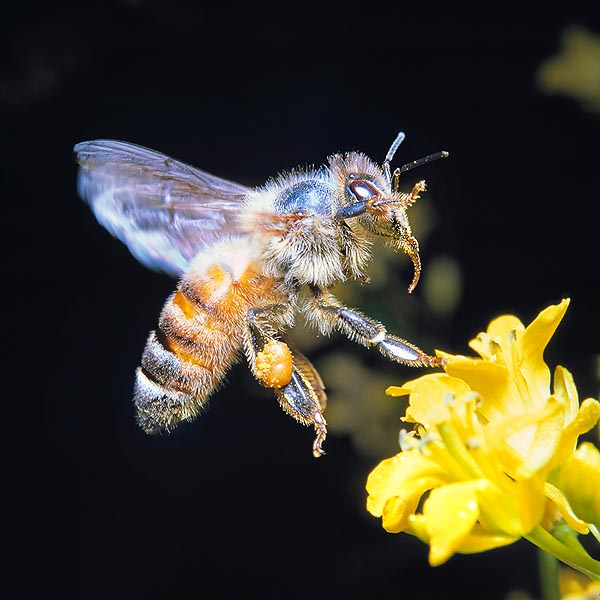
An Apis mellifera landing on a flower, with the extended proboscis © Giuseppe Mazza
Type: Arthropods (Arthropoda), subtype (Antennata), class Insects (Insecta), subclass Pterygotes (Pterygota), order Hymenopterans (Hymenoptera), suborder (Apocrita), family (Apidae), genus Apis, species Apis mellifera Linnaeus, 1758.
The social life of the bees is known since the most remote ages (Sumerian, Egyptian, Phoe- nician, etc., civilizations). Biologists and breeders have left us often well precise information about their breeding (apiculture) and on how to have the honey, golden and sweet fruit of the laboriousness of these special insects, always available.
But, for getting a precise and deep knowledge of the customs, the metamorphosis and the overall biological cycle of the society of the bees, we had to wait for the modern era, with the con- struction of artificial and transparent hives, with which to observe, always, the tangled social-interactive skeins of these hymenopterans.
Nevertheless, indeed, we have to recognize that many of their mysteries have not yet been unveiled (this applies to all the eusocial insects: that is, those where an organized society is evident, with castes, like the wasps, ants, termites, etc.) or that at least, a full explanation has not yet been given.
In the bees society, with an architecture subdivided in castes interacting following very sophisticated socio-biological and behavioural modules, there are three type of individuals, each one delimiting a caste: fertile females or “queen bees”, sterile females or “workers” and finally, the males, called also “drones”, which, in realty, are the laziest members of the whole society, dedicated only to the enjoyable phenomenon of the reproduction.
Such society is defined as “pluriannual” due to the enormous number of generations which characterize the huge offspring of the queen, of matriarchal type due to the presence of the queen as leader and “polymorphic”, seen that a precise morphotype corresponds to each one of the three castes.
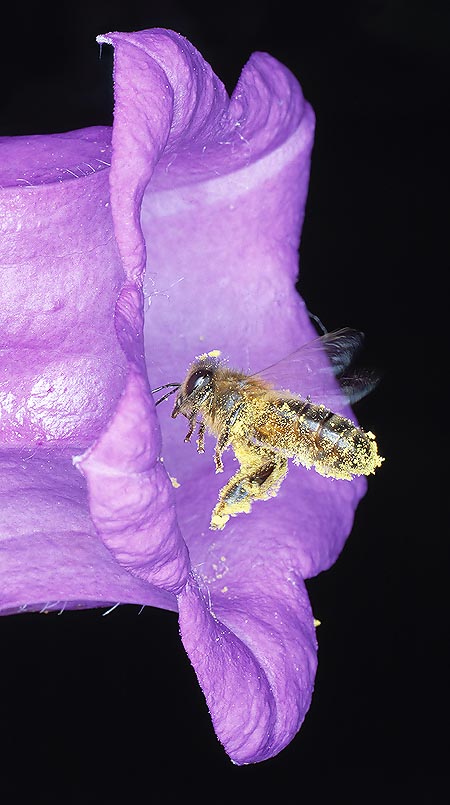
The bees allow the crossed fecundation carrying the pollen © Giuseppe Mazza
The queen of Apis mellifera or Apis mellifica, as it was later called by Linnaeus himself, a name still used today by some beekeepers, is larger than the other inhabitants of the honeycomb, as it reaches even the 2 cm of length, with a massive and elongated abdomen containing up to 180 ovarioles.
It does not have specialized organs for the collection of the pollen, neither “wax glands, secreting waxy substances”, nor “hypopharyngeal glands”, apt to feed the larvae.
At different stages of their vital cycle, these activities are prerogative of the “workers”, usually present, especially in the European hives, with 50.000-100.000 individuals, which finally transform in “foraging bees” or “pollinating insects”, charged of the complex process of the collection of pollen, the production of honey and the fecundation of the flowers.
While sucking the sweet nectar of a flower, in fact, they collect, more or less involuntarily, the pollen with the “brushes” and carry it with small containers placed in the hinds.
The workers are also devoted to the nutrition and the parental cares of the queen and of the larvae born from the ovules laid by her.
The drones, which are planned for the reproduction only, vary from 500 to 2.000 per hive.
All larvae, both those which will generate workers (the females), those from which will come the drones (the males) and those which will generate a future queen (female matriarch), have a waxy colour and are called “eucephalic” and “apodous”, because the head is much developed and are legless.
The larvae planned to form the future queens pupate after 15-16 days of life; those planned to become workers have the same metamorphose when about 21 days old, whilst the males do not pupate before reaching the 24th day of life.
All larvae, regardless the morphotype they will produce, convert in an “adecticous pupa”, which means almost completely motionless, “exarate”, therefore with free appendices covered by own cuticle, and “evoic”, because the “chrysalis” withdraws into a silken, or of other material, cocoon, made by the insect while developing.
All live in the state of pupa for a period varying for each caste, then later on, transform into imagos (counterparts of the adult), and get out from their cell where they were enclosed, under form of “winged morphotypes”.
This means that the queen, the worker and the drone are equipped with wings covered by a membrane hardening when in contact with the air, from which the name of the order Hymenopterians (Hymenoptera), compound word meaning “wings with membranes”.
The queen, cared as said by the workers, is nourished with “royal jelly” (diet which will never modified during its life), a much sweet and tonic blend, also produced by the “hypopharingeal glands” of the workers.
The larvae, which will originate the drones and the workers are, but just for a short initial time, fed upon “royal jelly”, and then, successively, upon pollen and nectar, obviously only by the nursing bees. An appellative which is perfectly identifying their efficiency and function.
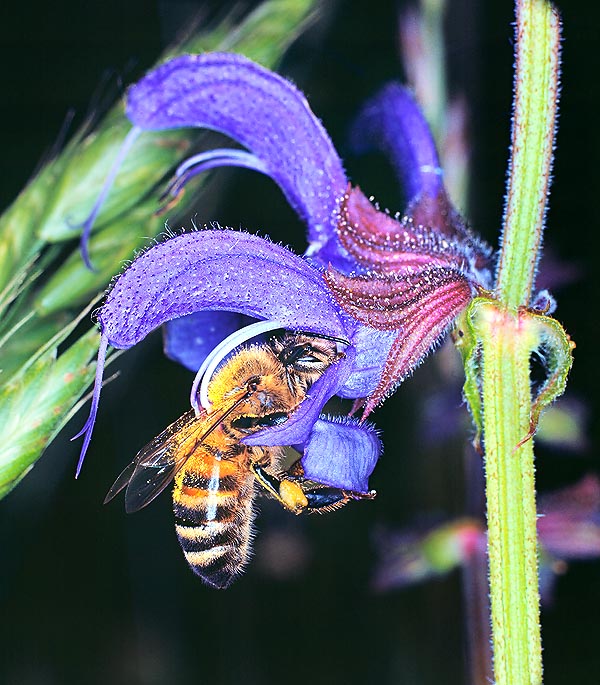
The evolution of flower plants is strictly related to the activity of the bees. Some plants, like the wild sage (Salvia pratensis) have even invented footrests and rockers for the visiting pollinators © Giuseppe Mazza
The nutrition, in quantitative and qualitative terms, acts on the maturation of the secondary somatic sexual characters, such as the number of the dentils of the sting and the size of the same.
The “wax glands”, defined in fact as “secreting waxy substances glands”, always present only in the workers, are on the other hand utilized for building the honeycomb and for closing the entrance to the hexagonal cells with a waxy film acting as a door.
Inside these cells, we may find a larva under development or in incubation with a certain quantity of food (royal jelly and, later on, also pollen if workers and drones will come to life), or food only. In this case, they are utilized as stores of royal jelly, pollen or honey, once the trans- formation of the pollen from which it comes has ended.
The hexagonal cell is an internal architectonic-structural characteristic of the hive, reiterated in hundreds of copies (a real structural module), inside which may be placed the newborn larvae in incubation, in the ratio one cell/one larva, or food as alimentary reserve.
The geometrical complexity, evident when observing a transversal section of hive, in terms of number of cells as well as of structural organization, which is very close to the fractal geometry, shows the high grade of social intelligence characterizing these animals, still so much mysterious for us, even if they are bred since thousands of years.
A similar complexity, maybe even greater, is found also from the casts made by pouring liquid plaster from the main entrance inside the empty nests of ants, which also belong to the quite vast order of the Hymenopterians (Hymenoptera), and of the termites, which are belonging to the order of the Isopterans (Isoptera) compound word which means “wings with the same dimensions”. The result is always a complex construction, comparable to a real urban architecture, almost one of our cities, with resting areas, areas of nutrition, areas of reproduction, roads, etc.
Going back to the honeycombs with their closed small cells, the growing larva will always find there the food furnished by a worker, through the hypopharingeal glands, and a sufficient volume of air for breathing during the development, while hundreds of workers keep, outside the entrance, the right temperature and humidity of the place, parameters which are also fundamental for the correct development of the insect.
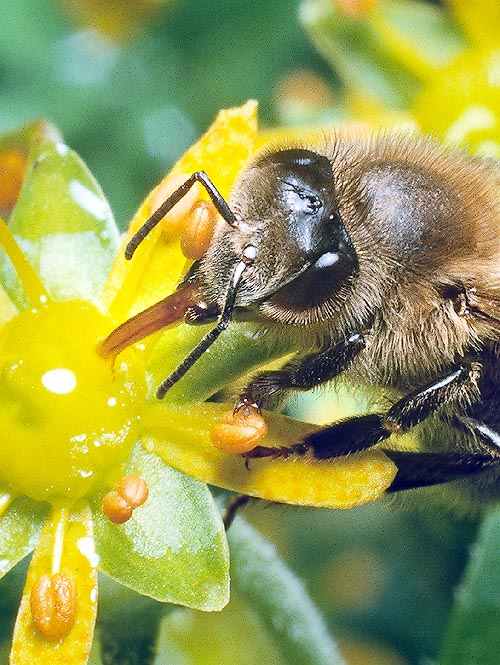
The contract with the plant is clear: I feed you and you pollinate me © Giuseppe Mazza
In this sort of micro-incubator with hexagonal geometry, the larvae remain until the “unfurling”, when the nymph or the imago of the bee come out, absolutely similar to the adult, but smaller, and will reach the same size after a consecutive series of enhancements.
Also the maturation of the wings, called “sclerification”, will take place during such time, as already briefly said. They dry up from the humidity covering them and get stronger, covering themselves with a chitinous-elastic membrane in order to be apt for flying. The various characteristic veins organize in geometries called, them too, “cells” and form the support of the wing.
From this moment on, the young bee will behave as worker, if the larva has originated from an ovule fecundated with sperm of drone (by amphigony or amphimixis) or as drone, if it has originated from non-fecundated ovules, by a parthenogenetic process present in this domestic hymenopter and other species of the order, called “Arrenotokous parthenogenesis”, without fecundation.
The queen shows a total absence of homo-parental cares towards the immense number of larvae, forming the countless generations of progeny produced during the time. It may be defined as a cold-hearted “reproductive unit”, or, better, a “brooding unit”, more than a mother, in the most literary sense of the term.
It is a real genic entity with a karyotype formed by 32 chromosomes, dedicated to the propagation of its alleles and nothing else.
All the cares of the honeycomb, like keeping it clean and adequately aerated, the parental cares of the larvae and of the nymphs, queen included, are always duty of the countless workers, which, furthermore, like real stakhanovites, must collect the food, protect the honeycomb from the foes, and keep constant the internal temperature and the humidity of the nest. They must guarantee, in short, all the functions which are essential so that the society where they live may keep in a homeostatic balance.
We have seen that the drones are born by parthenogenesis (Arrenotokous virginal reproduction, that is, that type of parthenogenesis which originates only individual of masculine sex, opposed to the Thelytokous, which generates only feminine individuals and the Deuterotokous, which originates, in different proportions, individuals of both sexes) from the eggs laid by the queen, which, being haploid, have a karyotype n = 16 chromosomes.
The feminine workers, born by amphigony, thanks to the gamic fusion of a spermatozoon with an ovule, like the potential new queens, have, on the contrary, a diploid karyotype 2n = 32 chromosomes.
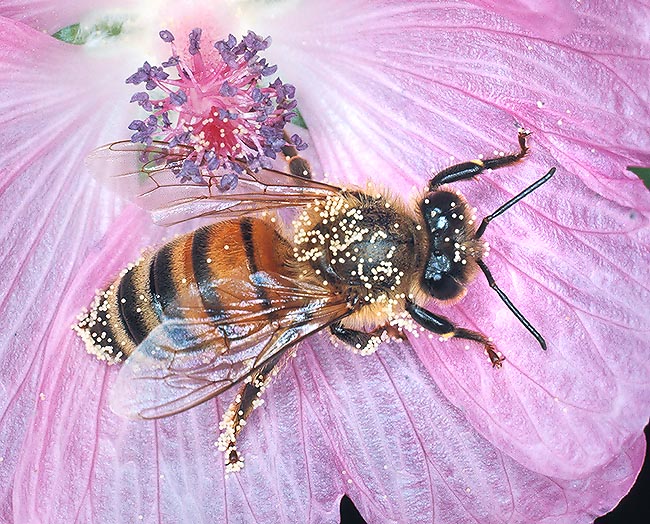
Apart honey, the bees are essential for the human agricultural activities © Giuseppe Mazza
Exceptionally, it may happen that diploid males are produced by homozygosis. These larvae are immediately identified by the nursing workers and killed.
This identification takes place maybe by means of the emission made by the larvae of particular pheromonal substan- ces, related to the sex, or of somatic characters (relating to the somation), unknown to us, which however do not escape the nurses.
From these numerous generations, will be born, sooner or later, a new diploid queen (2n), which will replace the old one, dead of disease or killed by the workers themselves because too old.
But usually, the old queen goes on in performing its function, and the new one migrates elsewhere with a certain num- ber of drones and workers, seeking a new nest for building up a new society.
This phenomenon is called “swarming”. Practically, there are no phenomena of territorial struggle for becoming head of the natal society and a latent sort of peace does exist.
The “neo-queen” performs the nuptial flight 5-6 days after the “unfurling” coupling with a variable number (from 6 to 8) of drones, whose sperm is con- served in special structures called “spermatophores”, where it is maintained without alterations for several weeks. It will use it, after a principle not yet discovered (maybe it is capable to understand, both qualitatively and quantitatively, the ratio which is most suitable in the community between workers and drones), for fecundating the ovules released by its “ovarioles”, which, by now enlarged, have inflated the abdomen.
The oviposition takes place after 1-3 days, for the birth of workers, or, avoiding the fecundation, of drones or haploid bees by Arrenotokous parthenogenesis.
Often the copulatory apparatuses of the male (drone) are removed and remain inside the female copulative organ.
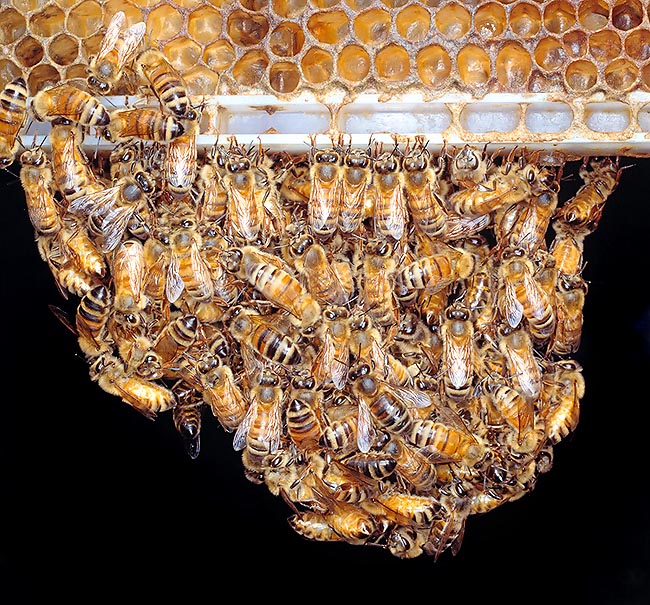
A living chain of workers building a hive. The use the wax secreted by special glands © Giuseppe Mazza
They form what the entomologist biologists call the “fecundation mark”, and will be removed, later on, by the workers.
This applies also to the old queen who, like the new queen, migrated by swarm- ing to create a new society, effects nuptial parades coupling with the drones.
The workers are smaller than the queen as well as the drones, the real lazy and idle members of the society (we shall justify later the reason of this).
They have the “glands secreting waxy substances”, of the wax, the “hypo-pharyngeal” ones, but are equipped also of small baskets and brushes in the back legs, useful for collecting the pollen when they will live as foragers and as pollinators.
They too have ovarioles, but in number of 10-12.
They are almost always inactive or atrophied, by sure during the old age they transform in foragers; the workers may exceptionally be called to act as regents when the queen dies too early (due to sickness or other cause), and a new queen has not yet come to life for the replacement.
It is an odd proceeding.
One of the workers, the criterion with which the selection of the subject between 50.000-100.000 units happens is not clear, transforms (becoming fertile), in queen “ad interim”, till when a new, effective, one comes to life and assumes the legitimate position.
Furthermore, the workers are the only bees equipped with a sting, or prickle, connected to a poison gland which, at the bite, causes agonizing pain. In the humans, a bite of Apis mellifera, as indeed happens with the Asian giant hornet (Vespa mandarinia), may cause, when the bitten subject is allergic, a serious “anaphylactic shock”. If not immediately assisted, with cortisone and antihistamine drugs, the unlucky victim may die, and this applies also for the animals when attacked by the bees.
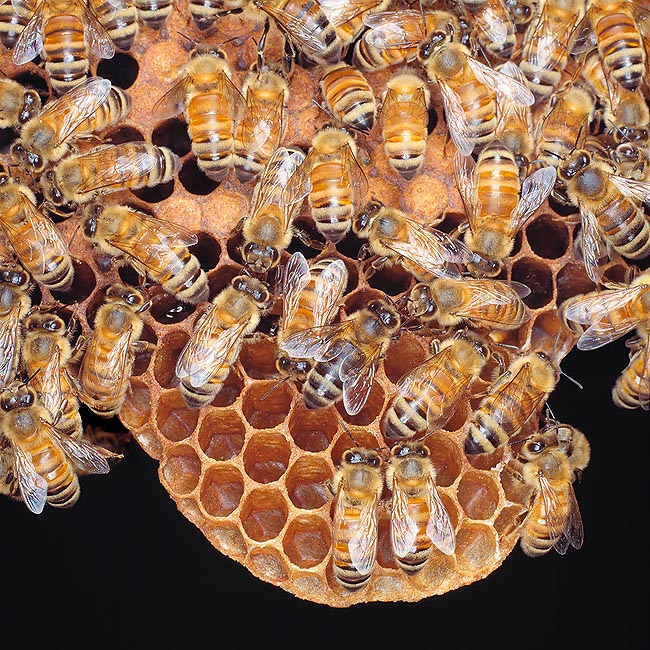
Besides building hives, the workers collect food, feed the queen, the drones and larvae, keep constant the inner temperature and humidity of the honeycombs, which they also defend with the life from possible foes © G.Mazza
Whilst, after the bite, the sting may be removed from the tissues or the rigid cuticle of the insects, this on the contrary is retained, and ripped with the guts, by the elastic skin of the mammals, thus causing the death of the female bee. A phenomenon which is more frequent in the bees than in the wasps, where the sting attached to the body of the insects makes a greater resistance.
Previously, I have defined the drones as the least active members of the society, but maybe I have been too severe in judging them so negatively.
It is true that their apparent idleness identifies them as loafers; while they buzz around the hive without even caring to defend it from possible foes, but it is not their fault, as this behaviour depends on their incomplete anatomy and physiology. They are not provided of a working buccal apparatus, and all along their life they depend, for the food, from the workers.
The well known mechanism of reward-fecundation, which happens when a foraging-pollinating bee sucks the nectar with the proboscis from the floral nectars, is the trigger spring of the flowers pollination.
Very old evolutionary phenomenon caused by specific ecologic conditions, which stands at the base of the reproduction of an ample range of plants, the Angiosperms (Angiospermae), which reproduce by means of the “flower”.
While nourishing, passing from a corolla to another, the bee carries the pollen collected from another flower of the same species; this is at the base of the crossed pollination. This reproductive phenomenon has been defined by the biologists (botanists and zoologists), “entomophilous” reproduction, that is by means of an insect. It would be long to discuss about a mechanism which stands at the boundary between the two main branches of the Biology (Zoology and Botany) and which, even now, has not yet unveiled all what it has to tell us.
For instance, how and why a bee decides to visit only a certain flower, of a certain vegetal species, ignoring on the contrary those of other species, or why it returns more times just on the same flower, for that specific vegetal species (showing memory and discrimination capacities), ignoring flowers of close conspecific plants, which are on the contrary object of the interest of other foraging bees of the same hive and of the same society.
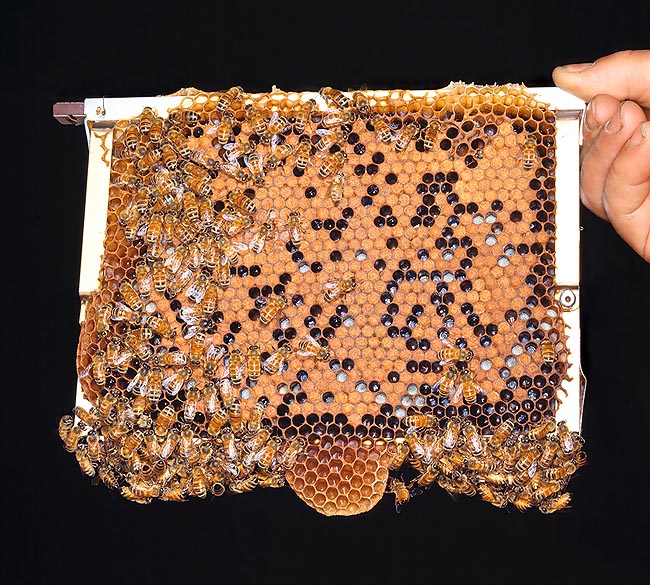
Frame extracted from the hive barehanded. The Apis mellifera is much less aggressive than what thought © Mazza
Maybe, in this case, it takes place a sort an individual-specific marking of the host flower, thus becoming not interesting for the wishes of another “pollinating” com- panion.
This characteristic of the bees is utilized in biologic agriculture, for guaranteeing the reproduction of edible-officinal plants, such as the colza, the zucchini, the pumpkin, the watermelons and many others, obviating to the artificial polli- nation.
From countless etho physiologic, entomo physiologic and botanic researches, of zoology and ecology on the field, also defined “physiology on the country”, the biologists become increasingly aware (and about this matter hundreds of publications do exist) that the flower plants with their entomophilous reproduction, have evolved along with the Bees (Apis mellifera) and other pollinating species.
The co-evolutionary processes have led the plants which rely on these pollina- tors, to produce flowers in function of the eyes of the bees, capable to perceive the polarized light and the colours of the spectrum, with wavelengths falling in the red-orange-yellow.
That is the reason why we often find these colours in the corollas , not to forget the “androeciums” and the “gynoeciums”.
The eye of a worker bee is formed by about 4.000 ommatidia, whilst the drones have, in their eyes, more than 7.500 of them. This is an evident character of sexual dimorphism. These eyes, complex and compound, allow the workers, become “foragers”, to discriminate among the thousands of flowers present in the wild, those having true “nectars” from those which do not have the same.
It is possible that the perfume of the flower plays a specific role, acting as alimentary attractor for the bee, always keeping the reproduction of the plant as purpose.
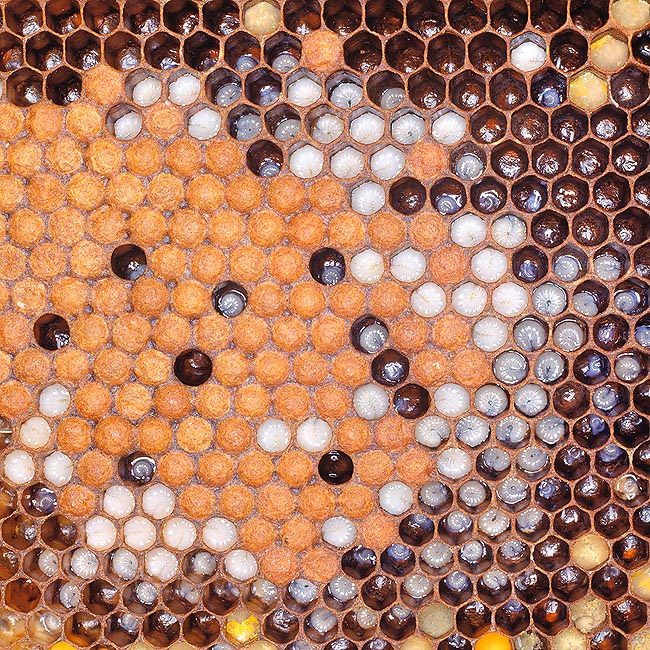
Honeycomb with the typical hexagonal cells. Larvae at various development stages, pollen and honey © G. Mazza
The smell has a form which is convertible in an electric variation into the nervous system of the bee.
As a consequence, to a smell, perceived through the antennae, will correspond a specific “antennogram”, which is the physiologic equivalent of the electroence- phalogram of the vertebrates.
It’s in this way that the discriminatory process takes place as well as the choice and the identification of the flower, made by the bee, based also on the smell.
Bees development and relevant functions
The different duties performed by the worker bees are assigned in base of their age.
When just unfurled and with the wings not yet well sclerificated, they wander between the hives without performing any job, but quite soon, they become nurses and foster mothers of the queen as well as of the growing larvae now close to pupation.
As previously said, therefore, they shall maintain the wax cells, clean the nest and collect the honey and the pollen of the older foraging companions when they come back to the honeycomb, an incomplete sort of “trophallaxis”.
After two or three weeks, they become real and true “amazons”, specialized in the defence of the honeycomb, ready to hinder the entrance to the enemies, parasites and even to bees belonging to other communities.
Finally, when old, they reach the highest step of the hierarchy accessible to them, becoming, rightly, pollinators or foragers.
By that time they carry on exclusively this task, flying even at hundreds of metres from the hive, looking for flowers for lapping their nectar with the proboscis and load the pollen. This is swallowed into a special diverticle of the oesophagus, the “honey sac”, where it is immediately submitted to processes of enzymatic digestion by glycosidases, which will be followed, in the nest, by the evaporation of part of the watery contents, for getting to the formation of the sweet product we all know: the “honey”.
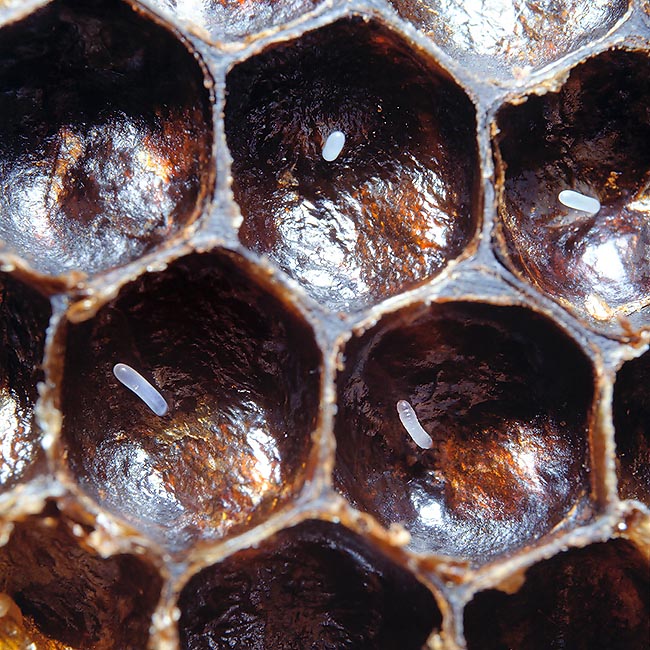
Upright just laid eggs. Two old horizontal eggs and one transforming in larva © Giuseppe Mazza
To be more precise, not all the pollen ends into the “honey sac” for the digestion: a part is simply accumulated on the brushes, in the back legs and transferred, by means of the combs, in the baskets of the tibiae for the carriage to the nest.
Once here, it is stored as food reserve or converted into honey inside the cells.
By the end of the day, the foraging bees, completely tired, go back to the honey- comb for resting.
The language of the Bees
In the bees’ society, like in those of the other eusocial insects, there is a more or less codified language, which may be more or less simulated.
For instance, when a queen is born, ready for migrating from the old nest to form a new society, a small group of workers and drones precede it seeking a suitable abode, like the interior of a hollow tree or a rocky ravine.
Once found the suitable place, they show its location to the queen with simulated codes, by means movement of the body and flying modalities. The queen under- stands and flies up solemnly, followed by all its population.
The workers, once in the new nest, will secrete the wax and will begin the con- struction of the hives, formed by the classical hexagonal cells, whilst the queen, after having coupled with the drones, cared and defended by the other female bees, starts to lay thousands and thousands of eggs, till the end of its long life, which may reach the four years, which represent an enormous duration in the insects world.
But the most complete and concrete evidences on the language, simulated in dance by the bees, were gotten by the historical and sensational experiments carried on for thirty years, by the Austrian Biologist Karl von Frisch, who won the Nobel Prize, in collaboration with other two biologists, Konrad Lorenz and Nikoolas Tinbergen, in 1973 for his studies.
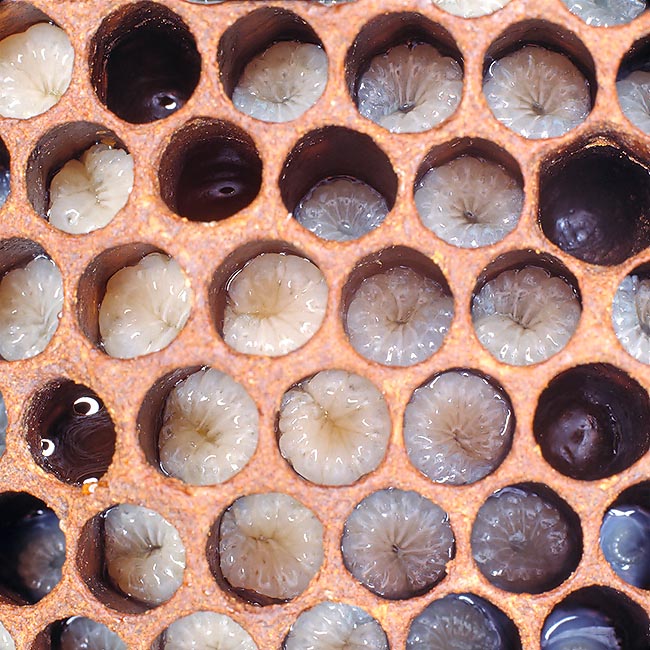
The waxy coloured larvae have very developed head and are legless © Giuseppe Mazza
These three scientists, along with the German biologist Oskar Heinrot, are considered as the founders of the scientific animal Ethology.
As we have described before, the bees are endowed of a complicate language which utilizes, besides the chemo-reception, tactile, visual and auditory stimulations.
K. von Frisch and his colleagues have effected accurate observations on the communicating means of the bees and have discovered at least two basic mechanisms utilized by these social hymenopterans for informing the com- panions of honeycomb (more precisely, the females) about the location of the nectar, the pollen and of other alimen- tary sources.
A “circular dance” of the foragers, gone in exploration, indicates that the food found is placed not far away from the hive, whilst the so-called “dance of the tail” (partly done swinging the abdomen, i.e. “wagging the tail”) indicates that the food is far away.
Usually, both dances are done inside the honeycomb, in the darkness, whereby only thanks to the chemo-receptors and the tactile receptors placed on the antennae, which are leant on the dancing foragers, the other worker bees may realize what kind of food is involved and, by following in detail the form of the dance, they may get information about the distance and the location of the food source.
At times, a low and particular type of humming accompanies this dance.
The dancing foraging bees, coming from a collection of food, after having repeated the dance several times, go back, flying, towards the source of food, accompanied by other pollinating bees who have understood the information received.
Until the food source remains remarkably abundant, the dance is repeated by any return to the hive; but when the food resource is close to the end, the foraging bees go on in carrying the food, but by each return do not perform any more the informing dance.
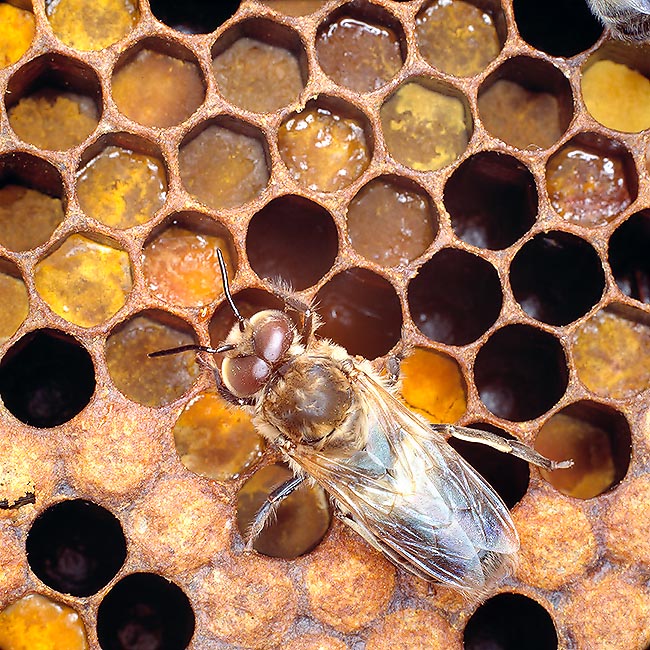
The drones serve to fecundate the queen. Due to their incomplete mouth, they are fed by workers © G. Mazza
As a matter of fact, it is not any more necessary to increase the number of the foragers for carrying the food.
The “circular dance” performed when the source of food is close to the honeycomb, consists in a series of small circles, before in one direction (i.e. clockwise or vice-versa) and then in the opposite direction (anti-clockwise or vice- versa).
Once the exploring bees have repeated the dance more times, they leave the honeycomb, followed by other foragers excited by the informing dance.
Thy will fly around the honeycomb till when they localize the source of food and go there. The “tail dance”, utilized when the source of food is distant for giving the direction and the distance of the food source, is done on a vertical surface of the honeycomb, and consists of three different phases: a semi-circular walk, a flight forward, and a new semi-circular walk, in opposite direction of the previous one, thus completing an ima- ginary circle.
The direction of the source of food referred to the honeycomb is shown by the short flight forward: is this is vertical upwards, the way to run is in direction of the sun; if it’s vertical downwards, the way is opposite to the sun; if it’s diagonal, the way differs of some angular degrees in respect to the position of the sun.
The rhythm with which the dance is performed shows the distance of the place in question from the honeycomb.
A slow rhythm, of about four dances per minute, indicates a distance of about 10 km; 16 dances per minute show a distance of about 1 km. There is therefore a relation of inverse proportionality between the rhythm of the dance and the distance to run: the greater is the rhythm of the dance, the minor is the distance to cover and vice versa.
Other details of the dance (its duration, the number of the wags during the forward flight, the buzzing accompanying them, etc.), provide further useful information to the foraging colleagues.
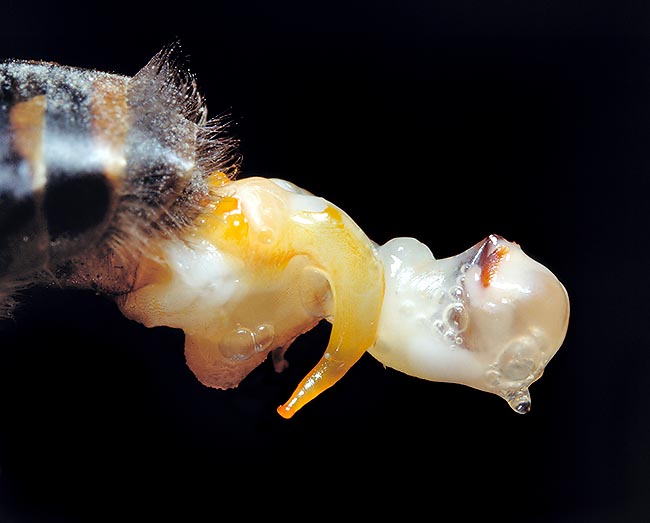
Drone sexual apparatus. The queen couples with 6-8 drones and keeps the sperm for weeks © Giuseppe Mazza
This shows how this complicated lan- guage is one of the richest in the world of the insects.
Much is still to be explained for under- standing it completely. A clarification of the same may be useful for a more rational and healthy agriculture as well as, maybe, for explaining us why during the last ten years, in all Europe and not only there, we are witnesses of phe- nomena of decline of the populations of Apis mellifera, along with a reduced reproductive index.
Beekeeping and parasites
Before treating about the major role held by the honeybee (Apis mellifera in the production of the honey and the wax, besides the royal jelly and the propolis (resinous substance collected by the workers from several species of plants), activities nowadays organized in a real industrial chain that goes by the name of “Beekeeping or Apiculture (and its per- former is called beekeeper or apiarist), we have to describe briefly, in primis, the various species and races of bees known to the Biology.
The genus Apis includes basically four species.
The first is the one we have treated till now: the Apis mellifera.
Second species is the Giant honey bee (Apis dorsata) of southern Asia, difficult to breed because very aggressive. It may, in fact, attack in huge swarms, animals and men, with, at times, fatal consequences.
Third species is the Indian bee (Apis indica), spread from India to Africa, characterized by poor working capacity and with the tendency to be nomadic, therefore little interesting for breeding purposes.
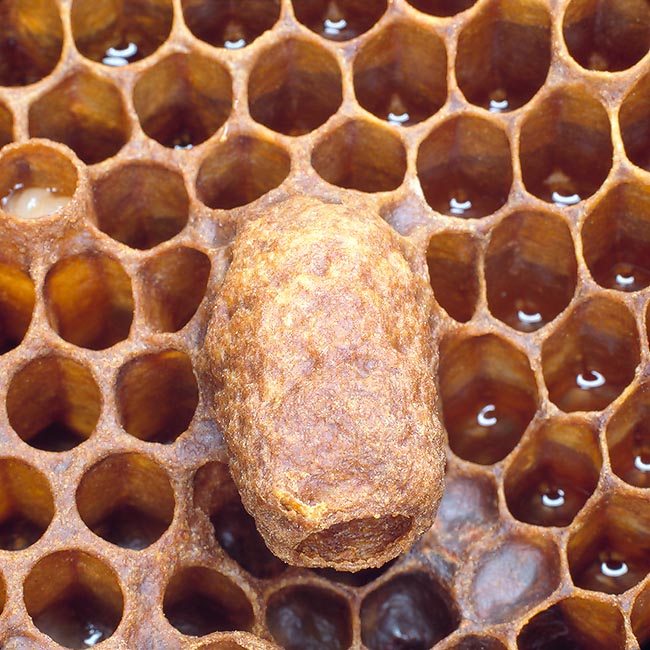
Hive with queen cell © Giuseppe Mazza
The fourth species is the Dwarf honey bee (Apis florea or Apis cerana), which loves the warmest areas, at low altitude, of southern Asia. It lives in small societies and modest honeycombs, producing only small quantities of honey, more or less equivalent to those produced by the wasps and consequently totally irrelevant in terms of trade.
The Apis mellifera is itself subdivided in several races or subspecies, such as the Apis mellifera ligustica, one of the most known, discovered in the thirties by the entomologist biologists, and the Apis mellifera mellifera.
Artificial hybrids are, finally, not missing, and they have introduced themselves into the natural ecosystems.
It is the case of the well known Africa- nized bee or Killer bee, involuntarily produced by the Brazilian biologist DrSc Warwick Estevam Kerr.
DrSc W.E. Kerr, expert on bees, was performing experiments in the depart- ment of entomology of the faculty of Biologic Sciences of the University of Brasilia, for getting more active bees, and consequently able to produce more honey, in tropical warm locations, like Brazil.
His purpose, obviously, was to help the local apiculture.
By the end of the fifties, he had introduced honeycombs of bees from Tanzania, in particular belonging to the African race Apis mellifera scutella. They were smaller bees than the European ones (Apis mellifera and relevant races) and more aggressive, but more suitable for the tropical environments.
Involuntarily, some tens of queens of Apis mellifera scutella, escaped from the honeycombs and were fecundated by the drones of the races Apis mellifera ligustica and Apis mellifera mellifera, till then used also in South America, by the beekeepers.
A biologic hybrid ensued, aggressive as the Apis mellifera scutella, but of bigger size, and therefore more dangerous than the original subspecies or race.
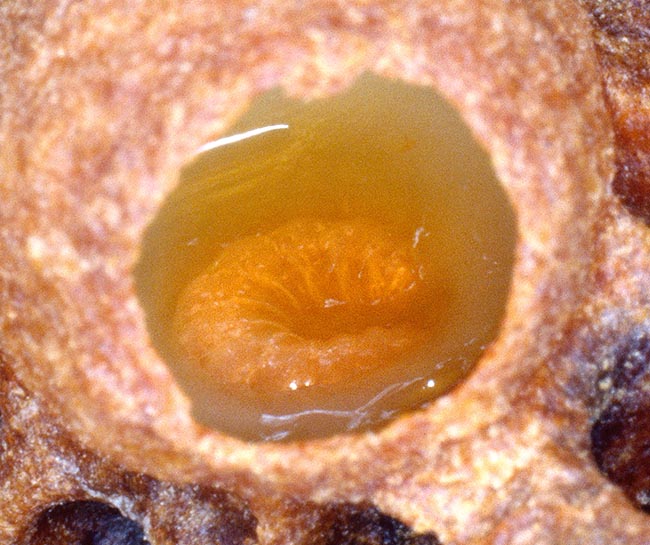
Queen larva in own cell. It will be fed with royal jelly by the workers for all its life © Giuseppe Mazza
The breeding of the bees, preferably Apis mellifera, done for getting honey, propolis, was, royal jelly, swarms and queens, has very old origins.
These ones date back to the time of the Egyptians, the Babylonians, and then of the Romans.
Activity kept in high regard when the honey was the only known sweetening substance, which declined after the discovery of America and the consequent diffusion of the sugar (cane and beet), not to forget the diffusion of materials substituting the wax.
Several works done by poets and georgic writers were dedicated to the life of the bees and to their rational exploitation.
With the introduction of the movable frame hive, of the foundations and of the “centrifugal honey extractor”, we can say that the modern apiculture had its beginning, thus not requiring anymore killing the bees for extracting the honey.
Still now, the Kikuyos, tribal population of the highlands of Tanzania and Kenya, greedy of the aromatic honey produced by the autochthonous bees, when they go hunting them, utilize the fumigation to confuse the workers defending the hive, and destroy the same for extracting the honey, ignoring the countless stings.
After some European beekeepers, this honey would appear to be more aromatic and tasty than that produced in the Old Continent. The success of the apiculture is much connected to the choice of the location where to place the apiary, to the crops grown and to the seasons’ course.
The spring blooming is not sufficient for ensuring the alimentation of the bees and a good production of honey. It is therefore necessary that the blooming prolongs till the summer and possibly the autumn, conditions which usually realize in locations placed at medium altitudes.
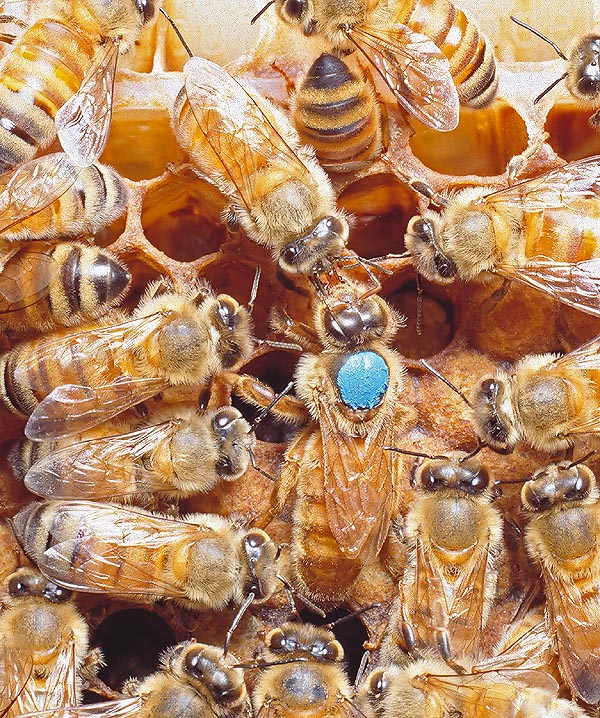
Blue-marked queen fed via trophallaxis by a worker. It may live about four years, a very long time in the insects world. Keepers marks it, just when born, with instant drying dye to identify it at once. An international calendar admits 5 colours as follows: the 2010 and 2015 are blue; the 2011 and 2016 are white; the 2012 and 2017 are yellow; the 2013 and 2018 are red and the 2014 and 2019 are green © Giuseppe Mazza
Moving from North to South, the ideal grazing is represented by the fields of clover, the orchards (Rosaceae), the lime, the alfalfa, the citrus groves, the carob trees and the cultivations of honeysuckle.
The necessary equipments are not expensive, unless we do not wish to proceed to big plants for industrial purposes.
The increase in bees farming has been always related to the diffusion of the associations of beekeepers, and the relevant legislation, it has therefore placed, as fundament of this discipline, the constitution of specific consortia, which may be optional or compulsory.
We now reach the end mentioning briefly some parasitic diseases which are, since always, cause of disease for the bees, up to determining the death of entire colonies, not to talk of the present disruption of environmental conditions and the electro-magnetic, “electro-smog”, pollu- tion, caused by the increasingly urgent and rapid urbanization, which lead several species of bees to a real collapse, compromising also their reproductive capacities.
The field entomologist biologists had already, since the end of the XVIII century and the beginning of the XIX, identified some parasitic pests lethal for the bees, but, with the development of the beekeeping, the biologists have been able to clarify more in detail their vital and parasitic cycles.
Among the various pests, two are real scourges for the colonies of Apis mellifera, with resulting commercial losses. They are the ectoparasitic mite (Varroa destructor) and the Honey bee tracheal mite (Acarapis woodi).
These parasitic mites are easily transmitted to the queens during the “swarming” with the accompanying drones and the workers, or during the flight of the stock of bees looking for new nests.
When these agents install in a hive, they cause inevitably the distrophyc alteration of the colonial homeostasis, leading the same to the total decay, till the complete exhaustion. This is creating serious problems to the beekeeping and consequently to the honey industry, but the main risk, after the biologists, is that these parasites, associated with other dangerous and environmental phenomena, may carry the Apis mellifera,
to the extinction, with incalculable damages to the global ecological balance.
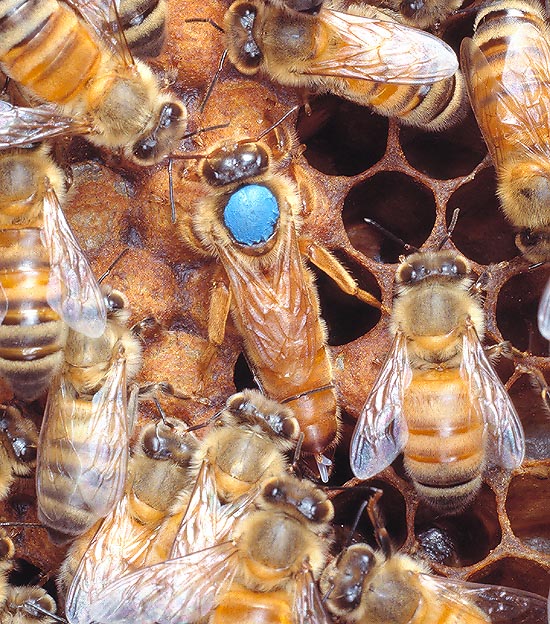
The queen while laying eggs: 2000 daily, some millions during the life © Giuseppe Mazza
The Varroa destructor, as clearly stated by its name, is particularly destructive for this species: it is the main biologic agent responsible of the demographic decline of the Apis mellifera, with enormous damages to the breeding.
It has been noted that the bees attacked by this agent modify, anticipating it, the foraging phase, lose the flight and orientation capacities, and that a rapid increase of the winter mortality takes place both for the single units as well as for the entire colonies, as the parasite spreads easily inside the hive when, for instance, a smitten worker goes back there.
The Honey bee tracheal mite (Acarapis woodi) is an infesting disease with a more variable impact.
Several studies of British entomologist biologists done during the seventies, have shown that it might not be a present menace for the demographic stability of the species Apis mellifera, whilst it has been the biologic cause of the devastations occurred in the northern USA during the XVIII century.
These studies have also shown that the Acarapis woodi is much more efficient, and therefore pathogen, in the cold countries, such as the northern USA and in North Europe for the boreal hemisphere, or at the extreme South in the Austral one.
Once installed in a colony of Apis mellifera, the tracheal mite causes the tendency to a reduction of the reproductive index, a difficulty in the breeding of the larvae by the workers, and their pupation, with an increase of the winter mortality, associated to a higher infective incidence, viral and bacterial.
If not timely treated by the beekeeper, the Varroa destructor, , which we have to keep in mind is an ectoparasite, is even more malignant. In just two years it can cause the collapse, destroying it, of a whole colony of honeybees.
The Varroa destructor, is a quite big hectoparasite, which develops and grows inside the cell of the forming bee.
The adult females of this mite enter the cell just before the larva pupates, release the eggs and bite the developing bee, for sucking the haemolymph, which they eat, as well as the developing eggs.
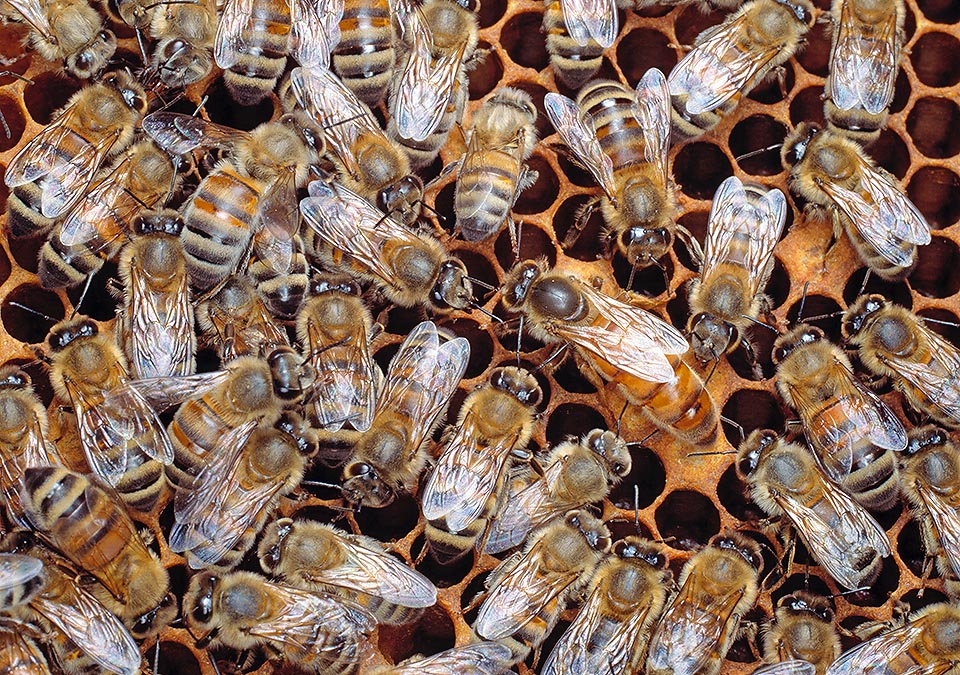
When a queen is born, at centre on right of the photo, it swarms with the workers and the drones for founding a new colony © Giuseppe Mazza
The Varroa destructor and its progeny do not kill the developing bee (real parasitism). They survive during the development (phoretic) of the bee, then adhere to the nymph, till little before the unfurling, for then passing to another cell, with a new larva under development.
The Tracheal mite (Acarapis woodi), on the contrary, carries on its complete vital cycle inside the tracheoles of the adult host.
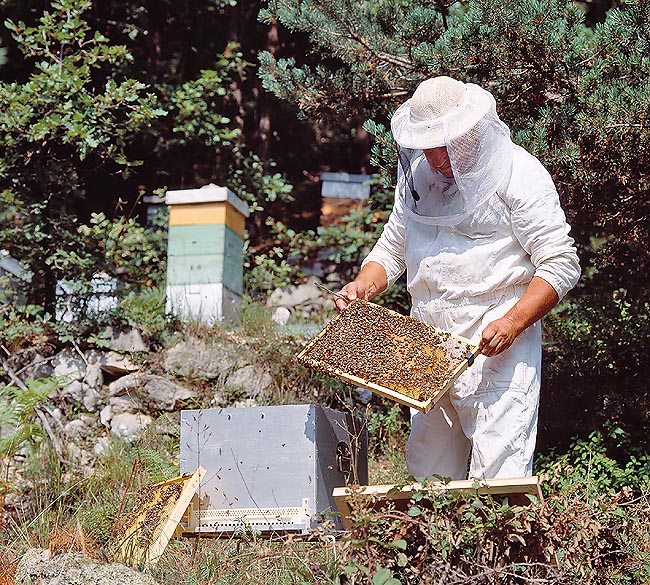
A beekeeper working. A hive may produce even 20 kg of honey yearly © Giuseppe Mazza
In fact, in the insects do not exist lungs, we talk of “pneustic” species, which breathe through the tracheoles, in contrast to the “apneustic” which, being not provided of tracheoles, breathe through the cutis.
By biting the tracheoles, they suck the heamolymph till when the host (a male or female adult bee) passes away. The progeny then abandons the host just to find another poor bee likely to be affected by the infestation.
In the past, the biologists thought that a honeycomb might be attacked, each time, by one or the other parasite, but recent researches effected on the field, have proved that both lethal parasites may be present in the hives of a colony at the same time.
The studies carried on by the field biolo- gists on the host-parasite evolutionary Biology and those done on the so-called Immuno-ecology, are nowadays funda- mental for unravelling the complicate fabric which regulates these processes of infestation and for finding an effective treatment, not yet available, to defend the Apis mellifera, which, we must not forget, also plays an important role in the pollination of many plant species and is without any doubt “essential” for the balance and the maintenance of the “biosphere”.
